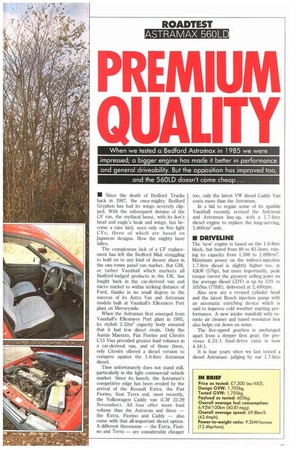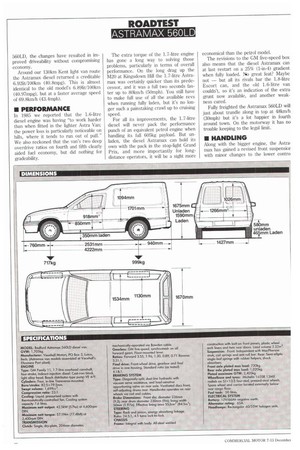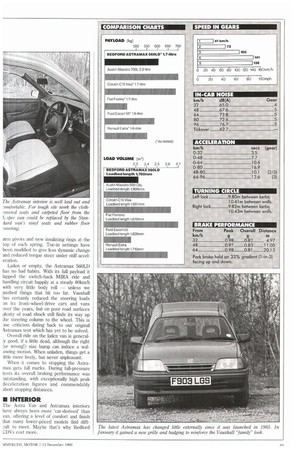QUALITY When we tested a Bedford Astra ax in 1985 we wer: _
Page 49

Page 50

Page 51

Page 52

If you've noticed an error in this article please click here to report it so we can fix it.
impressed; a bigger engine has made it better in perform.
and general driveability. But the opposition has improved and the 56OLD doesn't come cheap ...
• Since the death of Bedford Trucks back in 1987, the once-mighty Bedford Gryphon has had its wings severely clipped. With the subsequent demise of the CF van, the mythical beast, with its lion's head and eagle's beak and wings, has become a rare bird, seen only on five light CVs; three of which are based on Japanese designs. How the mighty have fallen.
The conspicuous lack of a CF replacement has left the Bedford Midi struggling to hold on to any kind of decent share in the one-tonne panel van market But GM, or rather Vauxhall which markets all Bedford-badged products in the UK, has fought back in the car-derived van and micro market to within striking distance of Ford, thanks in no small degree to the success of its Astra Van and Astramax models built at Vauxhall's Ellesmere Port plant on Merseyside.
When the Astramax first emerged from Vauxhall's Ellesmere Port plant in 1985, its stylish 2.32m3 capacity body ensured that it had few direct rivals. Only the Austin Maestro, Fiat Fiorillo and Citroen C15 Visa provided greater load volumes in a car-derived van, and of those three, only Citroen offered a diesel version to compete against the 1.6-litre Astramax diesel.
Time unfortunately does not stand still, particularly in the light commercial vehicle market. Since its launch, the Astramax's competitive edge has been eroded by the arrival of the Renault Extra, the Fiat Fiorino, Seat Terra and, most recently, the Volkswagen Caddy van (CM 22-29 November). All four offer more load volume than the Astravan and three — the Extra, Florin° and Caddy — also come with that all-important diesel option. A different threesome — the Extra, Fiorino and Terra — are considerably cheaper
too, only the latest VW diesel Caddy Van costs more than the Astramax.
In a bid to regain some of its sparkle Vauxhall recently revised the Astravan and Astramax line-up, with a 1.7-litre diesel engine to replace the long-serving, 1,600cm3 unit.
• DRIVELINE
The 'new' engine is based on the 1.6-litre block, but bored from 80 to 82.5mm, raising its capacity from 1,598 to 1,699cm3. Maximum power on the indirect-injection 1.7-litre diesel is slightly higher too, at 43kW (5'7hp), but more importantly, peak torque (never the greatest selling point on the average diesel CDV) is up by 13% to 105Nm (771bft), delivered at 2,400rpm.
Also new are a revised cylinder head and the latest Bosch injection pump with an automatic enriching device which is said to improve cold weather starting performance. A new intake manifold with remote air cleaner and tuned resonator box also helps cut down on noise.
The five-speed gearbox is unchanged apart from a deeper first gear; the previous 4.31:1 final-drive ratio is now 4.18:1.
It is four years since we last tested a diesel Astramax: judging by our 1.7-litre 560LD, the changes have resulted in improved driveability without compromising economy.
Around our 130km Kent light van route the Astramax diesel returned a creditable 6.9211000km (40.8mpg). This is almost identical to the old model's 6.891it/100km (40.97mpg), but at a faster average speed of 69.8km/h (43.4mph).
• PERFORMANCE
In 1985 we reported that the 1.6-litre diesel engine was having "to work harder than when fitted in the lighter Astra Van; the power loss is particularly noticeable on hills, where it tends to run out of puff." We also reckoned that the van's two deep overdrive ratios on fourth and fifth clearly aided fuel economy, but did nothing for gradeability. The extra torque of the 1.7-litre engine has gone a long way to solving those problems, particularly in terms of overall performance. On the long drag up the M20 at Kingsdown Hill the 1.7-litre Astramax was certainly quicker than its predecessor, and it was a full two seconds faster up to 80kni/h (50mph). You still have to make full use of all the available revs when running fully laden, but it's no longer such a painstaking crawl up to cruising speed.
For all its improvements, the 1.7-litre diesel will never pack the performance punch of an equivalent petrol engine when handling its full 605kg payload. But unladen, the diesel Astramax can hold its own with the pack in the stop-light Grand Prix, and more importantly for longdistance operators, it will be a sight more economical than the petrol model.
The revisions to the GM five-speed box also means that the diesel Astramax can at last restart on a 25% (1-in-4) gradient when fully loaded. No great feat? Maybe not — but all its rivals bar the 1.8-litre Escort can, and the old 1.6-litre van couldn't, so it's an indication of the extra grunt now available, and another weakness cured.
Fully freighted the Astramax 560LD will just about trundle along in top at 48km/h (30mph) but it's a lot happier in fourth around town. On the motorway it has no trouble keeping to the legal limit.
• HANDLING
Along with the bigger engine, the Astramax has gained a revised front suspensior with minor changes to the lower contro The Astramax interior is well laid out and comfortable. For tough site work the clothcovered seats and carpeted floor from the L-spec van could be replaced by the Standardvan's vinyl seats and rubber floor mvering.
arm pivots and new insulating rings at the top of each spring. Toe-in settings have been modified to give less dynamic change and reduced torque steer under stiff acceleration.
Laden or empty, the Astramax 560LD has no bad habits. With its full payload it lapped the switch-back MIRA ride and handling circuit happily at a steady 801un/h with very little body roll — unless we pushed things that bit too far. Vauxhall has certainly reduced the steering loads on its front-wheel-drive cars and vans over the years, but on poor road surfaces plenty of road shock still finds its way up the steering column to the wheel. This is one criticism dating back to our original Astramax test which has yet to be solved,
Overall ride on the laden van is generally good, if a little dead, although the right or wrong!) size bump can induce a wallowing motion. When unladen, things get a little more lively, but never unpleasant.
When it comes to stopping the Astramax gets full marks. During full-pressure tests its overall braking performance was outstanding, with exceptionally high peak deceleration figures and commendably short stopping distances.
• INTERIOR
The Astra Van and Astramax interiors have always been more 'car-derived' than van, offering a level of comfort and finish that many lower-priced models find diffi:ult to meet. Maybe that's why Bedford CDVs cost more. Even after an absence of four years, getting into the Astramax was like slipping into a familiar and comfortable arm chair. The interior design has changed little since 1985: the previous light and dark brown trim has been replaced by light and dark grey which should be just as easy to keep clean. Mind you, if you are planning to spend a lot of time on muddy sites, it would be worth forgoing the pleasures of the 1' trim, in favour of the 'Standard' van with its vinyl seats and rubber floor covering which will take more kindly to being sluiced out. Of course you could simply order the vinyl seats on the L van as a no-cost option.
The instrumentation and dash layout is straightforward. There is plenty of storage space, including a neat area behind the seats for tools. It's a pity that more use isn't made of the space above the driver's head (created by the curving cab roof line which rises to meet the large box body). A small Luton-style shelf over the driver would be useful for storing overalls or ropes.
Few drivers are likely to complain about the comfort of the L Astramax. The overall driving position is good, and the angled load bulkhead allows the seats to be raked back to accommodate long-legged drivers.
Visibility forward of the B-posts is above average, but on acute junctions side and rearward vision is more restricted. This isn't helped by the mirrors which, while firmly mounted, need to be larger and more convex to give a wider field of vision.
The visibility problem isn't helped by the fact that the Astramax's twin rear windows soon become obscured by road dirt, so the optional rear wipers (£1.01 ex-VAT) are well worth considering.
The stylish Astramax profile ends the myth that you can't incorporate a large box body into a flowing aerodynamic front end (Fiat please take note). The interior is generally well-finished. The load floor is made up of three sections, and while the seams between the floor pieces are well joined and sealed, there are still gaps big enough between the joints for wet sand and grit to collect and start corrosion.
Lashing points are built into the inner body frame, but there are none on the floor. The half-height bulkhead, fitted as standard on the Astramax, looks sturdy enough, but under heavy braking it started to bow forward towards the seats. An extra stiffening mid-rib would probably solve the problem.
Our biggest complaint concerns the poor fit of the rear doors and in particular of the door catches, which are flimsy and did little to prevent the doors swinging shut on our tester in a strong wind. Whether they will survive heavy use is debatable.
The 560 designation of the Astramax refers to its maximum uniformly distributed load in kilograms. With care you can carry more: we squeezed in our 605Kg helped by the good loading latitude on the axles.
Give or take the revised inlet manifold, trunking and front grille panels, nothing much has changed around the Astramax engine. The compartment is well laid out with every service item within reach, with the possible exception of the alternator which may prove harder to get to. We like the little light which comes on when the bonnet is raised and the headlights are on: it makes dipping the oil a practical proposition on a cold, dark morning.
• SUMMARY
The 1.6-litre diesel Astramax was a good van to start with, and the reworked 1.7 litre engine makes it better, both in terms of outright performance and driveability.
Our comparison charts show that it scores pretty well on fuel economy and payload against its main rivals, although there are vans with more carrying capacity, in both weight and cube.
The 560LD's drawback is its price, which is way above its rivals from Citroen, Fiat and Renault.
The Astramax is clearly a premium product: whether operators feel it justifies its price tag remains to be seen. The foreigners may not be able to match the build. quality of Vauxhall's Ellesmere Port plant, but is the average van buyer really pre. pared to pay up to .5:1,800 more for it?
0 by Brian Weatherley




















































































































































